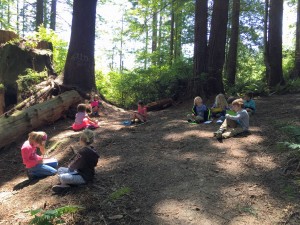Throughout history science and writing have been intertwined. Scientific discovery servers no purpose if it is not adequately communicated to those who can benefit from that knowledge. Much like the world at large, writing and science must also be paired in the classroom for the greatest benefit. Through integration with writing, science can be taught throughout the course of the day at all grade levels, increasing student access to STEM as well as increasing engagement. But the benefits go both ways since student writing is given more purpose thanks to hands-on experiences had in the classroom, lab, or field.
Here are three ways to integrate writing and science that move beyond the tried and true science journal (which still has value!) and also may increase the amount of time you spend teaching science and writing.
Structured Prompts
Structured prompts help students demonstrate their science understanding in a scaffolded way. For example: Compare the processes of erosion and weathering? While it may be easy to relegate such an assessment tool to the category of “short answer”, with the right wording and structure a prompt can be much more. Including, and defining within the question when appropriate, terms such as analyze, contrast, and justify pushes your students to not only consider the best way to communicate a target science principle more thoroughly, but can also help them build their informative writing skill (Bloom’s taxonomy action verbs can help generate more ideas). Imagine a student’s surprise if upon answering several structured prompts on cellular respiration they realize they have completed the body of an expository essay!
Sentence Frames
If you are unfamiliar with sentence frames, think of them as open-ended fill in the blank question, but supercharged! For instance, The difference between mass and weight are __________ and _________. The similarities between mass and weight are __________ and __________. When written carefully, sentence frames offer students of all ages the chance to explore a concept in a structured and uniform way, while at the same time not limiting them. At the monthly NGSS Collaborative Eureka High’s Rebecca Baugh provides sentence frames for K-12 teachers following her engaging demonstrations as way to demonstrate the inquiry-based learning model. The same frames are answered by all grade spans, each using vocabulary and concepts specific to their grade level. It’s amazing to see the diversity of answers and concepts the same prompt can yield!
Science-Writing Heuristic
A few years ago Seattle Public Schools completed a ten year study on the effectiveness of integrating writing and science in it’s elementary classrooms. Their findings, as you likely imagine, were resoundingly positive. Among their findings they concluded those educators who integrate writing and science taught both subjects more often, and with greater success. With proper teacher support the authors also determined using writing to teach science, and vice versa, led to improved standardized test scores in all subjects, an increase in expository writing in grades K-5, and increased access to science learning for diverse populations.
The idea of content integration is nothing new. But any teacher can tell you, simply because something is a good idea supported by research, shifting away from a conventional model can offer real challenges. However, many of the benefits of just a little more subject integration can be realized with only minor tweaks to your current practice.


